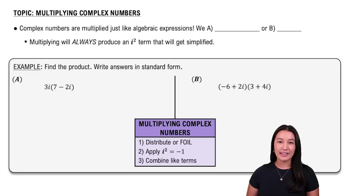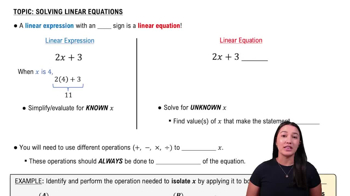Table of contents
- 0. Review of College Algebra4h 43m
- 1. Measuring Angles39m
- 2. Trigonometric Functions on Right Triangles2h 5m
- 3. Unit Circle1h 19m
- 4. Graphing Trigonometric Functions1h 19m
- 5. Inverse Trigonometric Functions and Basic Trigonometric Equations1h 41m
- 6. Trigonometric Identities and More Equations2h 34m
- 7. Non-Right Triangles1h 38m
- 8. Vectors2h 25m
- 9. Polar Equations2h 5m
- 10. Parametric Equations1h 6m
- 11. Graphing Complex Numbers1h 7m
0. Review of College Algebra
Solving Linear Equations
Problem 13b
Textbook Question
Find each sum or difference. See Example 1. -15 + 6
 Verified step by step guidance
Verified step by step guidance1
Identify the operation: This is a subtraction problem disguised as an addition problem, where you are adding a negative number.
Rewrite the expression: -15 + 6 can be rewritten as -15 + (+6).
Understand the number line: Start at -15 on the number line and move 6 units to the right because you are adding a positive number.
Calculate the new position: Moving 6 units to the right from -15 will land you at a new position on the number line.
Interpret the result: The new position on the number line is the result of the sum -15 + 6.
Recommended similar problem, with video answer:
 Verified Solution
Verified SolutionThis video solution was recommended by our tutors as helpful for the problem above
Video duration:
59sPlay a video:
Was this helpful?
Key Concepts
Here are the essential concepts you must grasp in order to answer the question correctly.
Addition of Integers
Addition of integers involves combining two whole numbers to find their total. In this case, when adding a negative integer (-15) and a positive integer (6), the process requires understanding that adding a negative number is equivalent to subtracting its absolute value from the positive number.
Recommended video:

Introduction to Common Polar Equations
Understanding Negative Numbers
Negative numbers represent values less than zero and are crucial in arithmetic operations. When performing addition with negative numbers, it is important to recognize that they decrease the total value, which can lead to a more negative result when combined with positive integers.
Recommended video:

Multiplying Complex Numbers
Order of Operations
The order of operations is a set of rules that dictates the sequence in which mathematical operations should be performed to ensure consistent results. In this case, since the operation is straightforward addition, the order of operations is not a concern, but it is essential to remember when dealing with more complex expressions.
Recommended video:

Algebraic Operations on Vectors

 7:48m
7:48mWatch next
Master Solving Linear Equations with a bite sized video explanation from Callie Rethman
Start learning



